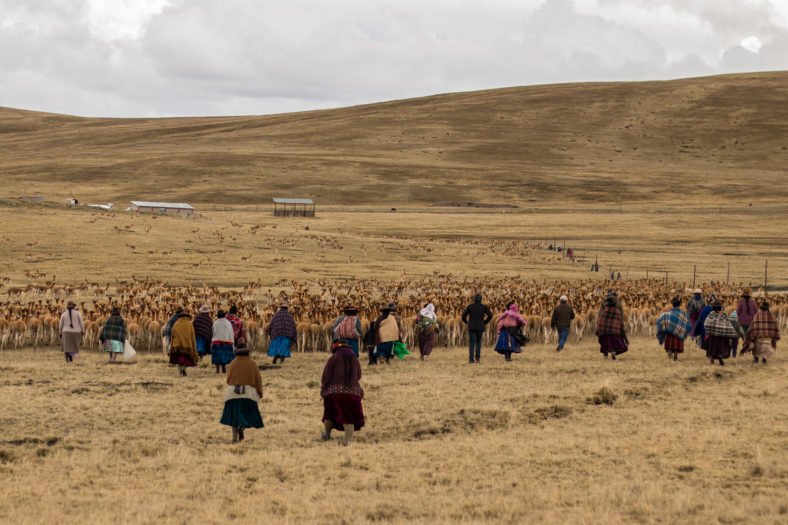There are four species of new world, or South American, Camelidae: the llama, alpaca, guanaco, and vicuña. They are usually classified as different species despite the fact they can interbreed and bear fertile cria. The vicuña bear the most valuable fiber – an ounce of their fiber sells for more than an ounce of silver. Yet just a few short years ago, they bordered on extinction. This is the story of their survival.
The Inca rulers, with their gift for organizing and governing vast territories, elevated the wild vicuña to exclusive status in their empire. The Sun Kings forbade the killing of vicuña. Instead, ceremonial hunts, or chaccus, were held annually. These hunts were an enlightened form of conservation. Thirty thousand people would form a half circle, beating drums and chanting, as the vicuña ran before them. With the human circle growing ever tighter, tens of thousands of vicuña were soon surrounded.
The vicuña were then counted, and the old and infirm slaughtered for their pelts and meat. The females, their cria, and the best male specimens were shorn and released. Thus, the vicuña prospered as the harvest of priceless fiber found its way to the Incan royal warehouses.
When the Spaniards arrived atop their horses with visions of sheep and cattle in their heads, vicuña and guanacos were slaughtered. Previously unknown diseases were introduced into the native herds by the Spanish sheep, and the population of vicuña wasted away.
In 1777, the Spanish colonists passed a law forbidding the hunting of vicuña, but the killing continued. After Peru gained independence from Spain, General Simon Bolivar, Peru’s first governor, tried to stop the slaughter by issuing many decrees that dictated severe punishment for anyone who killed the fragile vicuña. The governments of Chile, Bolivia, and Argentina followed suit, but nothing stopped the decimation of the vicuña, for their fleeces were too valuable to allow these defenseless animals to live. Poachers prevailed until there were almost none of the camelids left.
In 1965, the vicuña were finally declared an endangered species. The region known as Pampa Galeras, in the Peruvian department of Ayacucho, was designated a national vicuña reserve with 16,000 acres and 1,000 vicuña.
In 1965, there were approximately 20,000 vicuña in the world, almost all of them in Peru. Despite their new endangered species status, their numbers continued to decline due to relentless poaching. In 1995, Peruvian President Fuji Mori legalized the harvest of vicuña fiber from live animals declaring, “To save a vicuña, shear a vicuña.”
He gave the prized fiber to communities that were located within the natural habitat of the vicuña. Communities began to take pride in looking after the well being of the vicuña of their regions, and thus, former poachers turned into fierce protectors.
Today, there are more than 200,000 vicuña in Peru.
